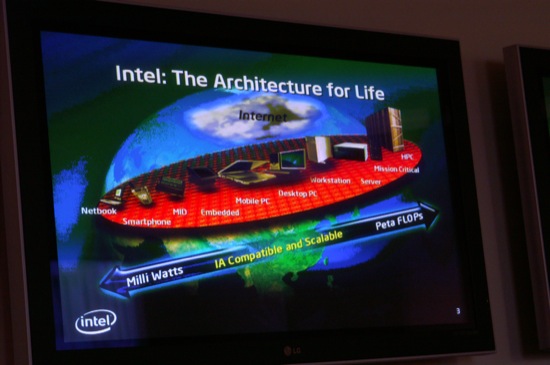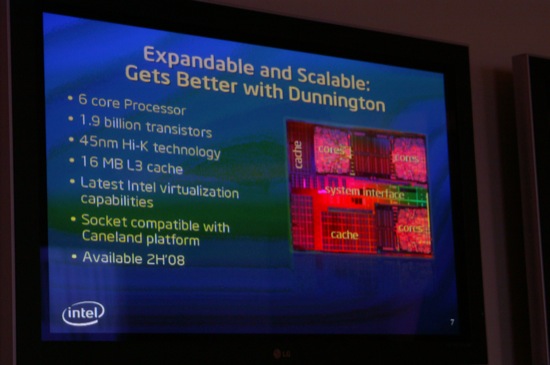Opening the Kimono: Intel Details Nehalem and Tempts with Larrabee
by Anand Lal Shimpi on March 17, 2008 5:00 PM EST- Posted in
- CPUs
Prior to its Intel Developer Forum, Intel is revealing a bit more detail on some new products coming down the pipeline - including Nehalem and Larrabee.
IDF is going to be all about scaling Intel Architecture from milli watts all the way up to Peta FLOPs. This is clearly a reference to the Intel Atom on the milli watts side and new high end quad-core Itanium and Larrabee products on the Peta FLOPs side.
First up is Intel's quad-core Itanium product, codenamed Tukwila:
Tukwila is Intel's first chip with a full 2 billion transistors and should be shipping by the end of this year, with full systems available next year. Tukwila, like Nehalem, will support Intel's QuickPath Interconnect (QPI), a point-to-point interconnect similar to AMD's Hyper Transport. Also like Nehalem, Tukwila will feature an integrated memory controller - two in this case.
Next up was the Intel Dunnington processor, a 45nm 6-core Xeon part based on Penryn cores:
With 6 cores (3 dual-core pairs on a single die) and a massive 16MB shared L3 cache, Dunnington is close to Tukwila in transistor count, weighing in at a whopping 1.9 billion transistors. Dunnington is the first shipping product to come out of Intel's India Design Team based out of Bangalore, India.
Architecturally there's not much difference between Dunnington and current Penryn based Xeon parts, you simply get more cores and a very large L3 cache shared by all of the cores. Designing such a beast isn't an insignificant effort, but it's made easier because when Intel designs a core it designs everything up to but not including the L2 cache. The L2 and everything external to it is referred to as the "uncore" and is made somewhat modular, although not quite to the same degree as Nehalem.
Dunnington is the first step in Intel implementing a very Phenom-like cache architecture with its future Core products, culminating in Nehalem.













53 Comments
View All Comments
Yongsta - Tuesday, March 18, 2008 - link
Anime Characters don't count.RamIt - Monday, March 17, 2008 - link
Yep, you are the only one that cares :)teko - Monday, March 17, 2008 - link
I also ponder on the title and image. Actually, I clicked and read the whole article trying to look for a connection.Yea, I think it's bad taste.
Owls - Tuesday, March 18, 2008 - link
Who cares. If only Elliot Spitzer paid his hookers in Penryns no one would have known.Deville - Monday, March 17, 2008 - link
Wow! Exciting stuff!AMD? Hello???
InternetGeek - Monday, March 17, 2008 - link
But would you rather buy a Tick processor or a Tock processor?In any case you have to accept that the following generation (Tick or Tock) will perform faster. It's how Intel makes money.
The scenario is that on keeping your computer for 3-4 years. I rekcon that's still the average time. Basically when your GPU can no longer play the new games decently. On the CPU side, I think buying a Tock processor might be a better deal because you're getting the refined version of your generation.
Problem is the way Intel introduces their SIMD extensions. I've seen that done randomly (Ticks or Tocks) and sometimes you do want to have those extensions.
Is there a way to correlate Ticks/Tocks and SIMD extensions?
ocyl - Monday, March 17, 2008 - link
For some unknown reasons, Intel's "tick-tock" terminology is used inversely of the same phrase's common understanding, per Page 4 of the article. With Intel, "tock" refers to a brand new generation, while "tick" refers to refinement of the current generation. Why this is the case, I have no idea.InternetGeek - Monday, March 17, 2008 - link
I think you got it wrong. It is perfectly explained at http://www.intel.com/technology/tick-tock/index.ht...">http://www.intel.com/technology/tick-tock/index.ht...Tick is a new silicon process, Tock is an upgrade.
---
Year 1: "Tick"
Intel delivers a new silicon process technology that dramatically increases transistor density versus the previous generation. This technology is used to enhance performance and energy efficiency by shrinking and refining the existing microarchitecture.
Year 2: "Tock"
Intel delivers an entirely new processor microarchitecture to optimize the value of the increased number of transistor and technology updates that are now available
---
InternetGeek - Monday, March 17, 2008 - link
Ehm, You're actually correct. Tick is the upgrade. Tock is the new thing.masher2 - Monday, March 17, 2008 - link
Not quite. "Tick" is the new silicon process (the shrink). "Tock" is the new uCore architecture. They're both "new things".From a refinement perspective, the Tick generation will also typically include uCore refinements, and the Tock likewise includes process refinements.